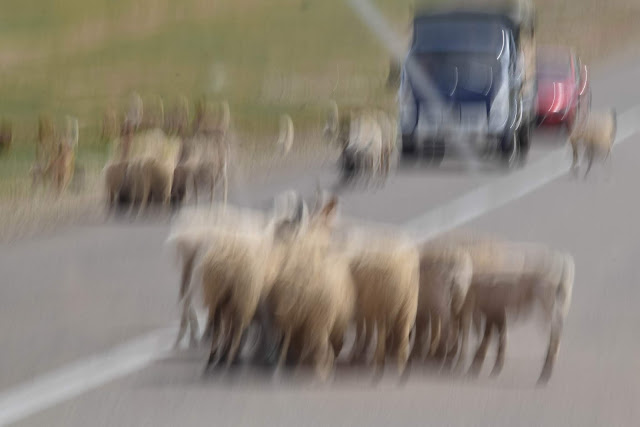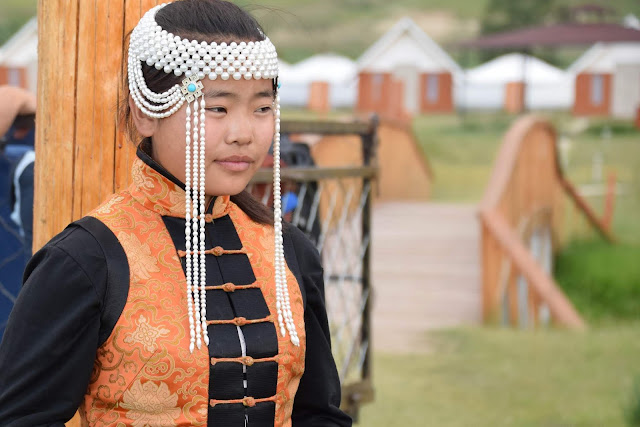Wednesday morning's transport was no more yellow bus, but three steely grey Russian vehicles known as UAZ's. We were assured that these were the best vehicles for Mongolia, as they can be fixed if they break down. Truer words were never spoken. I learned that the men who were our drivers were not just 'drivers', but 'on the spot' mechanical wizards!
 |
| Off we go! |
This was the beginning of our week's travel in the Gobi, to the south of Ulaanbaatar.
Before leaving 'civilization', we were able to stock up on any extras we needed at this rather splendid grocery store. I headed for the nuts and dried fruit.
Thus began our journey, which on this day was on a paved road, although there were times even it was pretty rough!
This presented the biggest challenge of the next seven days - how to get window space that allowed for photography and how on earth to find a moment when one was not bumping! The best vibration stabilization technology in my trusty Nikon just wasn't cutting it! I can assure you however, that this inveterate photographer didn't give up and we may yet find some successful pics from the van!
Our first stop at a mini-gobi ('gobi' means desert) also revealed the next challenge of the trip - how far must one walk to find a spot hidden from the road, for a pee? We had been told there might be occasions where we would have to find a bush - but we discovered that very often, there weren't even bushes!
The women in our group became quite good at scoping out gullies and even the scantiest of vegetation to provide the privacy we desired.
This was just a small patch of sand dunes - a tiny echo of the big one ahead, but it was still beautiful, and it was reassuring to see the ever-present gers off in the distance.
 |
| Wall of the Erdene Zuu Monastery, Kharkorin - in total there are 108 stupas |
Our destination for the day was a mere 7-hour drive to a town called Kharkhorin, close to the site of the original capital, Kharakhorum. Genghis Kahn declared the location of this lost city in 1220, but it was not built until 1235 by his son Ugedei Khan.
 |
| The best way to picture the city was from this scale model, based on descriptions from a French missionary Guillaume de Rubrouck who stayed there a few months in 1254. |
Its history as the capital was relatively short-lived - According to Wikipedia, Karakorum was reduced to be an administrative center for the Chinese Yuan dynasty in 1271 - becoming a provincial backwater. It had several more iterations as a city, and even re-emerged as the capital several times, but fell to ruin. It's whereabouts was questioned until the late 1800's. There is now a museum on the site, with artifacts from the old city, but we did not see any ruins while there.
 |
| One of the mosques as depicted in the model, |
Kharakhorum had been a cosmopolitan city, housing 10,000 to 15,000 people from many nations. It was notable for religious tolerance and had 12 Buddhist and Taoist temples, two Islamic mosques, and a Christian church.
This museum also housed an exhibit detailing a 6th century tomb of an aristocrat from an ancient nomadic tribe. This tomb has recently been excavated at Shoroon Bumbagar, which is located 220 km north east, about half way between Kharkhorin and Ulaanbaatar. It included a number of quite beautiful clay figurines.
This little bird was one of my favorites from that tomb - I loved both the color and his whimsical expression!
The most interesting items, however, were found outside the museum at the nearby Erdene Zuu Monastery. This Buddhist monastery was the first to be built in Mongolia. It is believed that stones from the ancient capital were used for construction in 1585 after Buddhism had been declared as the state religion of Mongolia. It was destroyed and rebuilt several times, but by 1872 had a full 62 temples and housed up to 1000 monks.
The collection of buildings were very reminiscent in style to those I had seen in Bhutan - definitely Tibetan influence, but the curved roofs suggest a Chinese influence also. Sadly, the religious complex became victim to the Russian inspired religious purges between 1937 and 1939. Implemented by the Mongolian communist leader many of the buildings here were destroyed. There are now three temples remaining, as you see above. Throughout the country, hundreds of monasteries in Mongolia were obliterated and over ten thousand monks killed during this purge.
During that time, rooms like this were emptied of religious items and used for grain storage. According to Lonely Planet, items like these were saved - possibly with the help of sympathetic officers - and buried in nearby mountains, or stored in local homes (at great risk to the residents).
Perhaps the remaining buildings might have been destroyed, but Wikipedia says that Stalin convinced the Mongolians to stop the destruction in 1944 so that the site could be used to demonstrate to visiting foreign dignitaries that the communist regime offered freedom of religion.
One of those visitors was Henry Wallace, the American Vice President under Franklin D. Roosevelt. (this dragon does not convey my opinion of Wallace - he was a progressive for his time and the Democratic Party Convention in 1944 used underhanded methods to get the nomination to Truman. Perhaps if Wallace had been on the ticket - there would have been no atom bomb. Just an aside - thanks for indulging me!)
As promised, it did have a serious collection of tsam masks!
In addition to the main three temples, there is a golden stupa, built at a later time in 1799.
My favorite building, because it is so Tibetan in style, is this Temple of Lavrin, which was built in 1784.
I had enjoyed my visit here. In spite of its grim history, the openness of the campus and incredible vibrancy of the collections created a spirit of great joy in me. It was well worth seeing.
At then end of the day, we were greeted at our ger camp by this lovely young woman, offering us a cheese snack as we arrived.
A good night's sleep should get me well prepared for tomorrow's journey south.




















No comments:
Post a Comment